In
our pilot review, we draped a slim, versatile electrode array above the floor of the volunteer’s mind. The electrodes recorded neural indicators and despatched them to a speech decoder, which translated the signals into the words and phrases the male meant to say. It was the first time a paralyzed man or woman who could not speak experienced applied neurotechnology to broadcast entire words—not just letters—from the brain.
That demo was the fruits of far more than a decade of study on the underlying brain mechanisms that govern speech, and we’re enormously happy of what we have completed so far. But we’re just acquiring begun.
My lab at UCSF is operating with colleagues close to the world to make this know-how secure, secure, and trusted more than enough for day-to-day use at dwelling. We’re also functioning to increase the system’s performance so it will be worthy of the work.
How neuroprosthetics perform
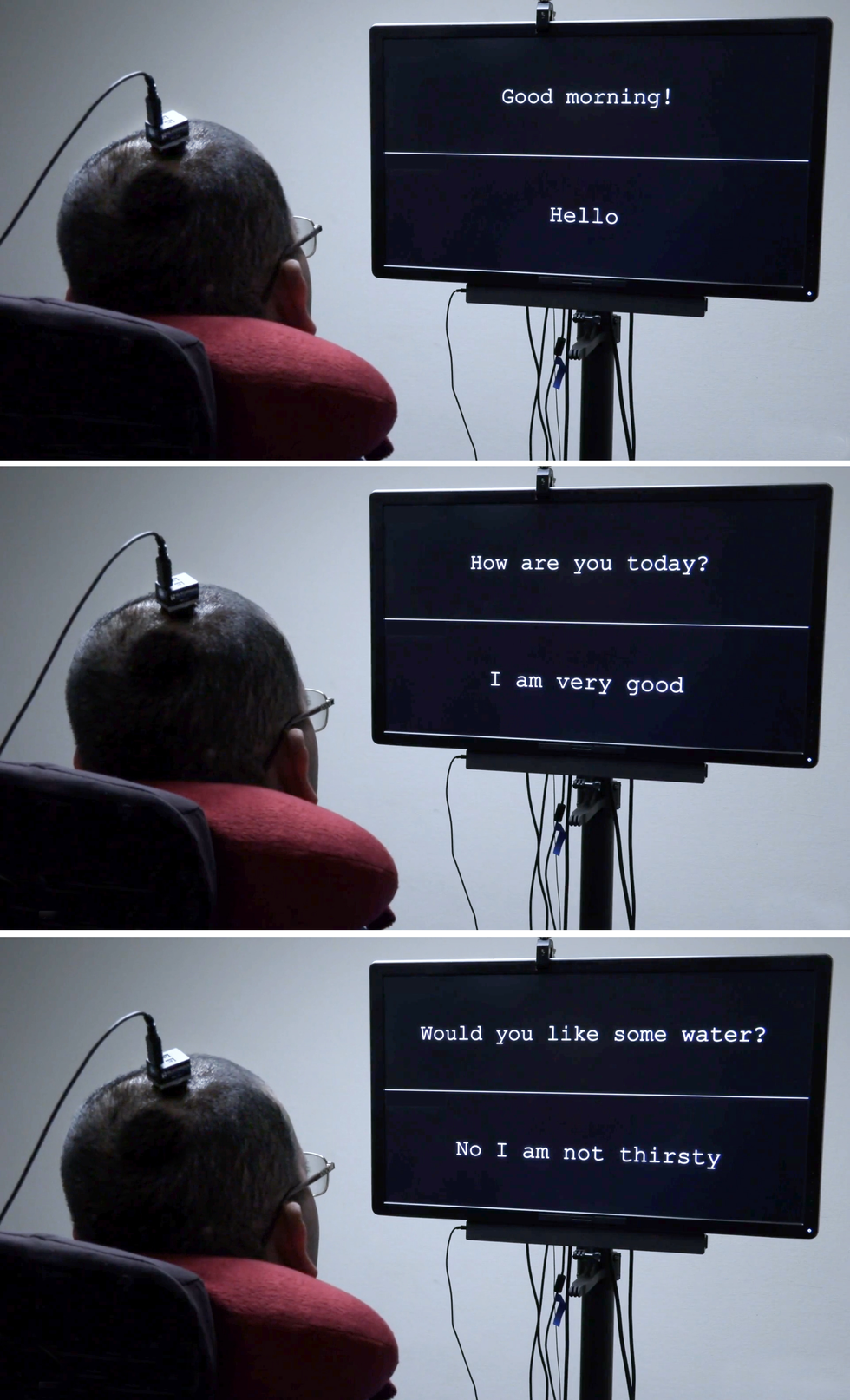 The to start with model of the mind-pc interface gave the volunteer a vocabulary of 50 realistic words and phrases. University of California, San Francisco
The to start with model of the mind-pc interface gave the volunteer a vocabulary of 50 realistic words and phrases. University of California, San Francisco
Neuroprosthetics have occur a extended way in the previous two a long time. Prosthetic implants for hearing have advanced the furthest, with layouts that interface with the
cochlear nerve of the inner ear or directly into the auditory mind stem. There is also considerable exploration on retinal and mind implants for vision, as nicely as endeavours to give men and women with prosthetic hands a perception of contact. All of these sensory prosthetics get details from the outside the house earth and transform it into electrical signals that feed into the brain’s processing centers.
The reverse type of neuroprosthetic data the electrical exercise of the brain and converts it into signals that handle a thing in the outdoors globe, this sort of as a
robotic arm, a video clip-sport controller, or a cursor on a personal computer screen. That very last regulate modality has been used by teams these types of as the BrainGate consortium to empower paralyzed individuals to sort words—sometimes a person letter at a time, from time to time utilizing an autocomplete operate to pace up the approach.
For that typing-by-brain operate, an implant is usually positioned in the motor cortex, the part of the brain that controls motion. Then the consumer imagines selected physical actions to regulate a cursor that moves about a digital keyboard. Yet another approach, pioneered by some of my collaborators in a
2021 paper, experienced a single user picture that he was keeping a pen to paper and was creating letters, building alerts in the motor cortex that were translated into text. That approach set a new document for speed, enabling the volunteer to publish about 18 text per moment.
In my lab’s research, we’ve taken a extra bold tactic. Instead of decoding a user’s intent to transfer a cursor or a pen, we decode the intent to manage the vocal tract, comprising dozens of muscles governing the larynx (generally known as the voice box), the tongue, and the lips.
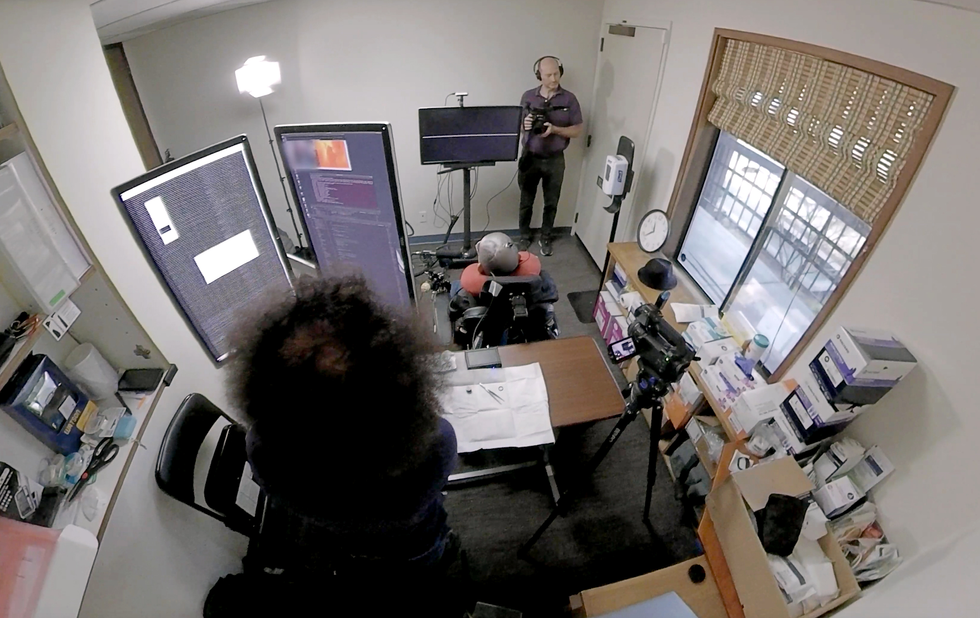 The seemingly very simple conversational setup for the paralyzed gentleman [in pink shirt] is enabled by both equally refined neurotech components and machine-finding out systems that decode his brain alerts. University of California, San Francisco
The seemingly very simple conversational setup for the paralyzed gentleman [in pink shirt] is enabled by both equally refined neurotech components and machine-finding out systems that decode his brain alerts. University of California, San Francisco
I started doing the job in this region much more than 10 a long time ago. As a neurosurgeon, I would normally see individuals with severe accidents that still left them not able to speak. To my shock, in many cases the destinations of mind injuries didn’t match up with the syndromes I learned about in clinical school, and I understood that we even now have a whole lot to find out about how language is processed in the mind. I decided to study the fundamental neurobiology of language and, if doable, to establish a mind-device interface (BMI) to restore interaction for folks who have misplaced it. In addition to my neurosurgical history, my group has knowledge in linguistics, electrical engineering, pc science, bioengineering, and drugs. Our ongoing scientific demo is testing both of those hardware and software to check out the boundaries of our BMI and decide what sort of speech we can restore to folks.
The muscular tissues included in speech
Speech is just one of the behaviors that
sets humans aside. A great deal of other species vocalize, but only human beings incorporate a established of appears in myriad distinct methods to signify the earth all over them. It is also an terribly difficult motor act—some authorities consider it’s the most complicated motor motion that persons carry out. Speaking is a item of modulated air move as a result of the vocal tract with each individual utterance we shape the breath by generating audible vibrations in our laryngeal vocal folds and shifting the shape of the lips, jaw, and tongue.
Many of the muscular tissues of the vocal tract are rather as opposed to the joint-centered muscular tissues such as individuals in the arms and legs, which can transfer in only a couple of recommended ways. For illustration, the muscle mass that controls the lips is a sphincter, even though the muscles that make up the tongue are ruled far more by hydraulics—the tongue is mainly composed of a fastened volume of muscular tissue, so transferring 1 aspect of the tongue improvements its shape elsewhere. The physics governing the actions of this kind of muscle groups is fully diverse from that of the biceps or hamstrings.
Due to the fact there are so a lot of muscle groups included and they each individual have so lots of levels of liberty, there’s effectively an infinite selection of doable configurations. But when folks talk, it turns out they use a somewhat compact established of main actions (which differ fairly in distinct languages). For example, when English speakers make the “d” sound, they put their tongues guiding their tooth when they make the “k” audio, the backs of their tongues go up to touch the ceiling of the back again of the mouth. Couple men and women are mindful of the specific, intricate, and coordinated muscle steps required to say the most basic word.
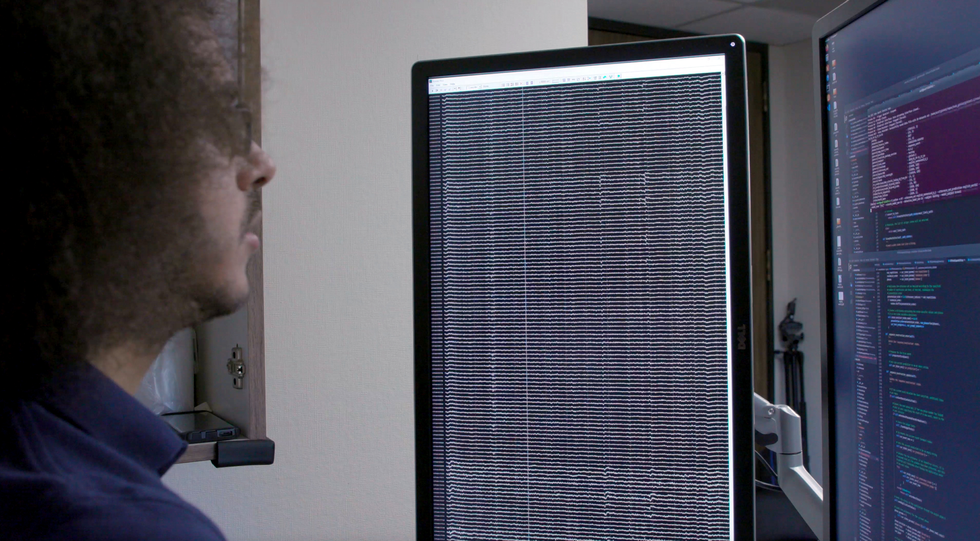 Team member David Moses appears at a readout of the patient’s brain waves [left screen] and a exhibit of the decoding system’s action [right screen].College of California, San Francisco
Team member David Moses appears at a readout of the patient’s brain waves [left screen] and a exhibit of the decoding system’s action [right screen].College of California, San Francisco
My analysis group focuses on the sections of the brain’s motor cortex that send movement instructions to the muscle tissue of the confront, throat, mouth, and tongue. All those mind regions are multitaskers: They regulate muscle mass movements that develop speech and also the movements of individuals similar muscle tissue for swallowing, smiling, and kissing.
Researching the neural exercise of these areas in a beneficial way requires both of those spatial resolution on the scale of millimeters and temporal resolution on the scale of milliseconds. Historically, noninvasive imaging techniques have been in a position to present 1 or the other, but not both of those. When we began this study, we uncovered remarkably minor details on how brain action styles were related with even the most straightforward parts of speech: phonemes and syllables.
Here we owe a credit card debt of gratitude to our volunteers. At the UCSF epilepsy center, people planning for surgical procedures typically have electrodes surgically put in excess of the surfaces of their brains for a number of days so we can map the locations associated when they have seizures. Throughout individuals couple of days of wired-up downtime, quite a few patients volunteer for neurological investigate experiments that make use of the electrode recordings from their brains. My team asked people to let us research their patterns of neural activity although they spoke phrases.
The components involved is identified as
electrocorticography (ECoG). The electrodes in an ECoG system don’t penetrate the brain but lie on the floor of it. Our arrays can comprise many hundred electrode sensors, every single of which documents from hundreds of neurons. So considerably, we have utilised an array with 256 channels. Our goal in those early research was to learn the patterns of cortical action when persons talk straightforward syllables. We asked volunteers to say distinct appears and phrases while we recorded their neural patterns and tracked the actions of their tongues and mouths. From time to time we did so by possessing them put on colored deal with paint and making use of a laptop-eyesight program to extract the kinematic gestures other situations we used an ultrasound device positioned below the patients’ jaws to impression their transferring tongues.
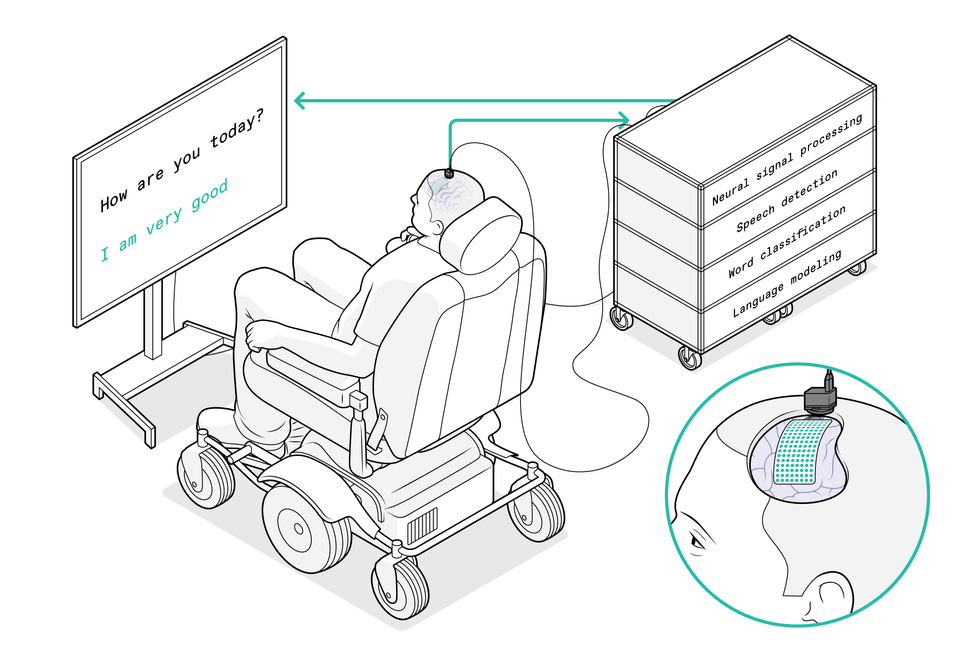 The procedure starts off with a versatile electrode array that’s draped around the patient’s brain to select up alerts from the motor cortex. The array particularly captures movement instructions intended for the patient’s vocal tract. A port affixed to the cranium guides the wires that go to the computer procedure, which decodes the brain indicators and translates them into the terms that the patient desires to say. His responses then show up on the exhibit display screen.Chris Philpot
The procedure starts off with a versatile electrode array that’s draped around the patient’s brain to select up alerts from the motor cortex. The array particularly captures movement instructions intended for the patient’s vocal tract. A port affixed to the cranium guides the wires that go to the computer procedure, which decodes the brain indicators and translates them into the terms that the patient desires to say. His responses then show up on the exhibit display screen.Chris Philpot
We used these devices to match neural styles to actions of the vocal tract. At initially we experienced a whole lot of questions about the neural code. A person probability was that neural action encoded directions for individual muscular tissues, and the brain essentially turned these muscular tissues on and off as if urgent keys on a keyboard. A different idea was that the code decided the velocity of the muscle mass contractions. However another was that neural exercise corresponded with coordinated designs of muscle mass contractions applied to produce a selected sound. (For illustration, to make the “aaah” audio, both of those the tongue and the jaw need to fall.) What we found was that there is a map of representations that controls different areas of the vocal tract, and that with each other the unique brain spots blend in a coordinated way to give rise to fluent speech.
The job of AI in today’s neurotech
Our work relies upon on the advances in artificial intelligence more than the past decade. We can feed the data we collected about equally neural activity and the kinematics of speech into a neural community, then let the machine-mastering algorithm obtain patterns in the associations involving the two facts sets. It was doable to make connections involving neural activity and manufactured speech, and to use this product to make pc-created speech or textual content. But this system couldn’t practice an algorithm for paralyzed individuals simply because we’d lack 50 % of the information: We’d have the neural designs, but practically nothing about the corresponding muscle movements.
The smarter way to use device finding out, we understood, was to break the dilemma into two measures. Initial, the decoder translates indicators from the brain into intended movements of muscles in the vocal tract, then it translates these supposed movements into synthesized speech or text.
We phone this a biomimetic technique mainly because it copies biology in the human system, neural action is straight dependable for the vocal tract’s movements and is only indirectly accountable for the appears created. A big benefit of this tactic comes in the education of the decoder for that 2nd step of translating muscle actions into sounds. Due to the fact individuals relationships concerning vocal tract movements and seem are pretty universal, we ended up ready to teach the decoder on massive details sets derived from individuals who weren’t paralyzed.
A medical trial to exam our speech neuroprosthetic
The future huge obstacle was to carry the technological know-how to the persons who could truly profit from it.
The National Institutes of Overall health (NIH) is funding
our pilot trial, which commenced in 2021. We currently have two paralyzed volunteers with implanted ECoG arrays, and we hope to enroll extra in the coming several years. The primary purpose is to improve their interaction, and we’re measuring efficiency in phrases of phrases for each minute. An typical adult typing on a complete keyboard can type 40 words and phrases for each minute, with the speediest typists achieving speeds of additional than 80 text per minute.
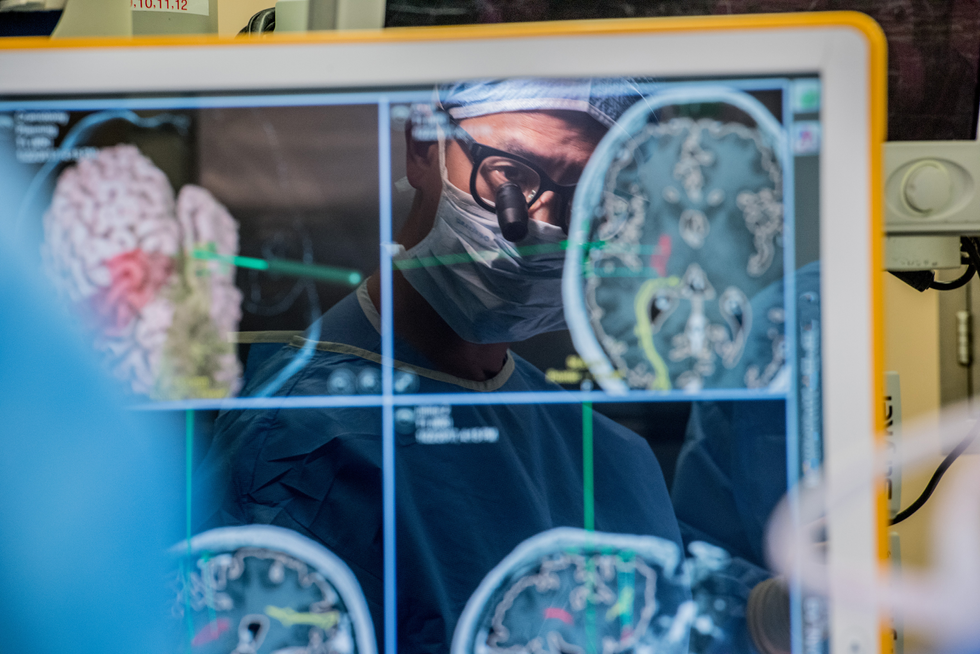 Edward Chang was impressed to create a mind-to-speech process by the clients he encountered in his neurosurgery practice. Barbara Ries
Edward Chang was impressed to create a mind-to-speech process by the clients he encountered in his neurosurgery practice. Barbara Ries
We think that tapping into the speech technique can offer even improved success. Human speech is much a lot quicker than typing: An English speaker can simply say 150 terms in a moment. We’d like to enable paralyzed folks to communicate at a fee of 100 text for every minute. We have a whole lot of perform to do to reach that purpose, but we believe our tactic can make it a feasible focus on.
The implant treatment is regime. Initially the surgeon eliminates a little portion of the skull upcoming, the adaptable ECoG array is gently placed across the area of the cortex. Then a modest port is preset to the cranium bone and exits through a different opening in the scalp. We at present have to have that port, which attaches to external wires to transmit info from the electrodes, but we hope to make the program wireless in the long term.
We have regarded employing penetrating microelectrodes, due to the fact they can report from smaller neural populations and may possibly consequently give more element about neural activity. But the current hardware is not as robust and safe as ECoG for clinical purposes, primarily around many several years.
An additional consideration is that penetrating electrodes commonly have to have each day recalibration to transform the neural signals into apparent instructions, and study on neural devices has demonstrated that speed of setup and efficiency dependability are essential to receiving folks to use the technological innovation. Which is why we have prioritized balance in
creating a “plug and play” method for prolonged-term use. We executed a study searching at the variability of a volunteer’s neural indicators more than time and discovered that the decoder executed far better if it used data designs across several periods and many times. In machine-studying conditions, we say that the decoder’s “weights” carried around, generating consolidated neural signals.
https://www.youtube.com/view?v=AfX-fH3A6BsUniversity of California, San Francisco
Due to the fact our paralyzed volunteers can’t talk whilst we observe their mind patterns, we asked our to start with volunteer to check out two diverse ways. He started out with a list of 50 words that are helpful for day-to-day lifetime, these as “hungry,” “thirsty,” “please,” “help,” and “computer.” Through 48 classes above numerous months, we occasionally asked him to just envision declaring every single of the words on the checklist, and often questioned him to overtly
check out to say them. We uncovered that attempts to converse created clearer mind signals and have been adequate to educate the decoding algorithm. Then the volunteer could use those terms from the record to produce sentences of his individual choosing, these as “No I am not thirsty.”
We’re now pushing to expand to a broader vocabulary. To make that do the job, we need to have to continue on to make improvements to the present algorithms and interfaces, but I am self-assured people improvements will transpire in the coming months and many years. Now that the evidence of principle has been founded, the purpose is optimization. We can concentration on earning our system a lot quicker, extra accurate, and—most important— safer and a lot more dependable. Things ought to move promptly now.
Probably the most important breakthroughs will arrive if we can get a much better knowing of the mind systems we’re striving to decode, and how paralysis alters their exercise. We’ve come to comprehend that the neural styles of a paralyzed individual who simply cannot send out commands to the muscle tissues of their vocal tract are pretty distinctive from those people of an epilepsy client who can. We’re making an attempt an bold feat of BMI engineering even though there is nevertheless loads to master about the underlying neuroscience. We believe that it will all arrive together to give our individuals their voices again.
From Your Web-site Articles or blog posts
Related Content articles Around the World wide web






More Stories
NPI Numbers and Legacy Numbers – New Rules As of May 23, 2008 For Billing Medical Insurance Claims
Magento Customization and Development
The History of the $500 Bill